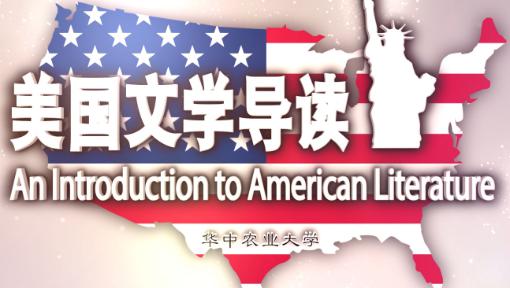课程简介
《美国文学导读》 是学习美国文学的一门入门级的课程,主要介绍美国文学发展各个历史阶段、重要文学流派及作家、文学概念等,使学习者了解美国文学发展的概况,美国文学史上出现的重要文学流派,他们写作的特征、基本的文学主张以及各文学流派的代表人物及主要作品、风格和主题等,并且通过作品阅读和分析,掌握文学赏析的基础知识和方法。
课程大纲
Introduction and Early Romanticism
1.1 General Introduction and Colonial Literature
1.2 American Literature of the 18th Century
1.3 General introduction to American Romanticism
1.4 Washington Irving
1.5 “Rip Van Winkle”
1.6 James Fenimore Cooper
1.7 The Last of the Mohicans
1.8 New England Poets
Transcendentalism and Romantic Poets
2.1 Introduction to Transcendentalism
2.2 Emerson and his Works
2.3 Nature
2.4 Thoreau and Walden
2.5 Walt Whitman
2.6 “I Hear America Singing”
2.7 Emily Dickinson
2.8 “Because I Could Not Stop for Death”
Dark Romanticism
3.1 Dark Romanticism
3.2 Edgar Allan Poe
3.3 “Ligeia”
3.4 “The Raven”
3.5 Nathaniel Hawthorn
3.6 The Scarlet Letter
3.7 Herman Melville
3.8 Moby Dick
American Realism
4.1 Regionalism / Local Colorism
4.2 Mark Twain
4.3 Tom Sawyer
4.4 Tom and Huck
4.5 American Realism
4.6 Henry James
4.7 The Portrait of a Lady
American Naturalism
5.1 American Naturalism
5.2 Stephen Crane
5.3 The Red Badge of Courage
5.4 Jack London
5.5 The Call of the Wild
5.6 Theodore Dreiser
5.7 Sister Carrie
5.8 Sister Carrie Chapter 47
American Modern Poets
6.1 Modernism and Modernist Poetry
6.2 Imagism
6.3 Ezra Pound and “In a Station of the Metro”
6.4 Hilda Doolittle and “Oread”
6.5 William Carlos Williams and “The Red Wheelbarrow”
6.6 Wallace Stevens and “Anecdote of the Jar”
6.7 T. S. Eliot and “The Love Song of J. Alfrek Prufrock”
6.8 Robert Frost and “The Road Not Taken”
“The Lost Generation” and Southern Literature
7.1 Lost Generation Writers
7.2 Fitzgerald and The Great Gatsby
7.3 The Great Gatsby Chapter 9
7.4 Earnest Hemingway
7.5 A Farewell to Arms
7.6 American Southern Literature
7.7 William Faulkner
7.8 The Sound and the Fury
American Dramatists
8.1 Development of American Theater
8.2 Eugene O’Neil
8.3 Introduction to The Emperor Jones
8.4 Expressionism in The Emperor Jones
8.5 Tennessee Williams
8.6 Introduction to A Streetcar Named Desire
8.7 Interpretation of Scene 1 of A Streetcar Named Desire
1.1 General Introduction and Colonial Literature
1.2 American Literature of the 18th Century
1.3 General introduction to American Romanticism
1.4 Washington Irving
1.5 “Rip Van Winkle”
1.6 James Fenimore Cooper
1.7 The Last of the Mohicans
1.8 New England Poets
Transcendentalism and Romantic Poets
2.1 Introduction to Transcendentalism
2.2 Emerson and his Works
2.3 Nature
2.4 Thoreau and Walden
2.5 Walt Whitman
2.6 “I Hear America Singing”
2.7 Emily Dickinson
2.8 “Because I Could Not Stop for Death”
Dark Romanticism
3.1 Dark Romanticism
3.2 Edgar Allan Poe
3.3 “Ligeia”
3.4 “The Raven”
3.5 Nathaniel Hawthorn
3.6 The Scarlet Letter
3.7 Herman Melville
3.8 Moby Dick
American Realism
4.1 Regionalism / Local Colorism
4.2 Mark Twain
4.3 Tom Sawyer
4.4 Tom and Huck
4.5 American Realism
4.6 Henry James
4.7 The Portrait of a Lady
American Naturalism
5.1 American Naturalism
5.2 Stephen Crane
5.3 The Red Badge of Courage
5.4 Jack London
5.5 The Call of the Wild
5.6 Theodore Dreiser
5.7 Sister Carrie
5.8 Sister Carrie Chapter 47
American Modern Poets
6.1 Modernism and Modernist Poetry
6.2 Imagism
6.3 Ezra Pound and “In a Station of the Metro”
6.4 Hilda Doolittle and “Oread”
6.5 William Carlos Williams and “The Red Wheelbarrow”
6.6 Wallace Stevens and “Anecdote of the Jar”
6.7 T. S. Eliot and “The Love Song of J. Alfrek Prufrock”
6.8 Robert Frost and “The Road Not Taken”
“The Lost Generation” and Southern Literature
7.1 Lost Generation Writers
7.2 Fitzgerald and The Great Gatsby
7.3 The Great Gatsby Chapter 9
7.4 Earnest Hemingway
7.5 A Farewell to Arms
7.6 American Southern Literature
7.7 William Faulkner
7.8 The Sound and the Fury
American Dramatists
8.1 Development of American Theater
8.2 Eugene O’Neil
8.3 Introduction to The Emperor Jones
8.4 Expressionism in The Emperor Jones
8.5 Tennessee Williams
8.6 Introduction to A Streetcar Named Desire
8.7 Interpretation of Scene 1 of A Streetcar Named Desire

